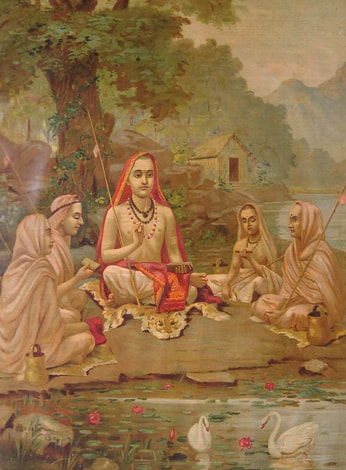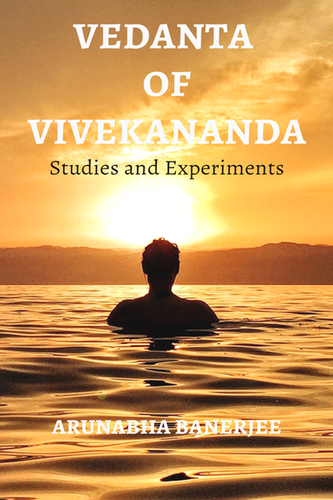 The Origin of the term Vedanta The term Vedanta literally meant ‘end of the Vedas’ or वेद्स्य अन्त: (Vedasya antaha) and deals with conclusion and goal of the Vedas and they represented the central aim and meaning of the teachings of the Veda. The Vedas- an Introduction The name Veda (वेद:) signifies wisdom, a genuine spirit of enquiry derived from the knowledge of Vedic Sages (Munis) who travelled the path of deep contemplation with a desire to investigate, inquire and understand the questions of philosophical nature pertaining to various aspect of our lives, spirituality, music, science and cosmos. Most followers of Hinduism know that there are four vedas, now let us look a bit deeper into the meaning and context of each of the four vedas: Rig Veda: The oldest document of the human history and oldest of the four vedas. Rg Veda comprises of songs of praise Rigvedic hymns are dedicated to deities, such as Indra, Vrtra; Agni, and Soma, including deities such as Adityias or Asura, gods Mitra–Varuna and Ushas (the dawn), Brihaspati or Brahmanaspati, along with natural phenomenons. Yajur Veda: The Yajur veda primarily deals with sacrificial formulas or mantras and includes about 1,875 verses, that are distinct yet borrow and build upon the foundation of verses in Rigveda. Sam Veda: The Samaveda is the Veda of Chants, or melodies (sāman) and the Rig verses. The Samaveda text contains notated melodies, and these are probably the world's oldest surviving ones. Atharva Veda: The Atharva veda was the last of the vedas to be compiled around 900 BCE and involves rites to address superstitious anxiety, spells to remove maladies believed to be caused by demons, and herbs- and nature-derived potions as medicine (origin of Ayurveda is attributed to Atharva Vedic texts). Atharva veda also has been the primary source for information about Vedic culture, the customs and beliefs, the aspirations and frustrations of everyday Vedic life, as well as those associated with kings and governance. The text also includes hymns dealing with the two major rituals of passage – marriage and cremation. Sections of the Vedas: Each Veda comprises of four sections, which are
As part of the Vedas the Upanishads belong to Sruti or revealed literature and are vehicles for more of spiritual illumination than of systemic reflection, revealing a world of rich and varied spiritual experience, rather than a world of abstract philosophical categories. One of the chief reason the Upanishads are called the end of the Vedas or Vedanta as they deal with conclusion and goal of the Vedas and they represented the central aim and meaning of the teachings of the Veda, thus the content of the Upanishads is the wisdom of the Vedas. The principal or mukhya Upanishads are said to be Ten (10) although most scholars consider them to be thirteen (13). However the great Samkara commented on Eleven (11) Upanishads. Each Upanishad is associated with one or more than one Veda. Name of the Upanishad Vedas to which they are associated Isa Upanishad Yajur Veda Kena Upanishad Sam Veda Katha Upanishad Yajur Veda Prasna Upanishad Atharva Veda Maandukya Upanishad Atharva Veda Taittriya Upanishad YajurVeda Aitareya Upanishad Rig Veda Chandogya Upanishad Sam Veda Bṛhadāraṇyaka Upanishad Yajur Veda Shvetashvatara Upanishad Yajur Veda References
1 Comment
Abbey
4/21/2019 11:55:56 am
Hi, very nice website, cheers!
Reply
Leave a Reply. |
About this section
This page hosts articles that are produced from my contemplation on topics and principles of Vedanta, which I prefer to see in the context of modern life and scientific education. Archives
February 2021
Categories
All

One question that has been bothering mankind since time immemorial is, what happens to us, where do we go once our body is dissolved. Various theories have been proposed by systems after systems, the dualists speak of threefold eschatology, where when a man dies he goes to heaven or goes to the sphere of the wicked persons to roam as ghosts and demons or falls back to earth only to be reborn as animals, here the non-dualists or Advaitists ask, how can one come and go, and to what place, especially when one is infinite? The very question of birth and death concerning this soul turns out to be nonsensical, as the soul or the self of the man is omnipresent and everywhere and the talks of birth and death, of havens and higher, havens, are a childish dream and vanishes the moment one realizes the truth.
|
 RSS Feed
RSS Feed
